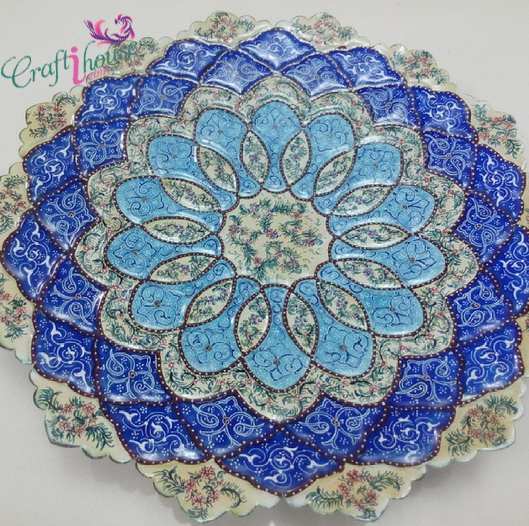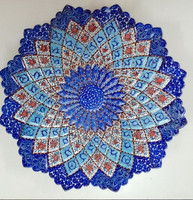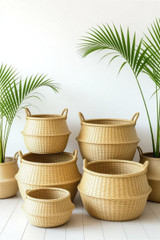Minakari , hand enamel painted copper plates , copper vase ,
Enamel is a brilliant art of fire and soil, whose history goes back to 1500 B.C.
Enamelworking and decorating metals with colorful and baked coats is one of the distinguished courses of art in Isfahan . Mina, is defined as some sort of glasslike colored coat which can be stabilized by heat on different metals particularly copper. Although this course is of abundant use industrially for producing metal and hygienic dishes, it has been paid high attention by painters, goldsmiths and metal engravers since long times ago. In the world, it is categorized into three kinds as below:
- painting enamel
- Charkhaneh or chess like enamel
- Cavity enamel.
The art of "Mina kari" or Enameling is an special coloring method with mina glaze to paint decorative dishes, pots and vases.
It is called miniature of fire, the art of painting, coloring and ornamenting the surface of metals by fusing over it with brilliant colors that are decorated in an intricate design. Mina is the feminine form of Minoo in Persian culture, meaning heaven. Mina refers to the Azure color of heaven.

What of more availability in Isfahan is the painting enamel of which a few have remained in the museums of Iran and abroad indicting that Iranian artists have been interested in this art and used it in their metal works since the Achaemenian Aand the sasanid dynasties. The enamels being so delicate, we do not have many of them left from the ancient times. Some documents indicate that throughout the Islamic civilization of and during the Seljuk & Safavid and Zand dynasties there have been outstanding enameled dishes and materials. Most of the enameled dishes related to the past belong to the Qajar Dynasty between the years 1810–1890 AD. There have also remained some earrings. Bangles, boxes, water pipe heads, vases, and golden dishes with beautiful paintings in blue and green colors from that time, Afterwards, fifty years of stagnation caused by the World War I and the social revolution followed. However, again the enamel red color, having been prepared, this art was fostered from the quantity and quality points of view through the attempts bestowed by Ostad Shokrollah Sani'e zadeh, the outstanding painter of Isfahan in 1935 and up to then for forty years.

Studies on enameling shows that Bizans enameling is based on Iranian
enameling. The oldest existing examples confirm the claim that the
enamel as well as many other arts were first found in Iran, then has
made its way to other countries. In the Mongolian era a new method in
metalworking and enameling came to existence. Arabic patterns and images
were replaced by images and patterns showing portrait and costume of
Iranian royals. During the Timurid era inlaying on metal reached its
most eastern style. In the Safavid era the patterns used in enameling
and metalworking went under change .During the era silver dishes were
ornamented with miniature patterns showing banquets of palaces, hunting
ceremonies and horse riding. Enameling also enjoyed spiral (Eslimi) and
floral patterns and red color became more common. Isfahan was one of
main centers of practicing enameling and still it is.
Enamel is
naturally transparent, this transparency is the result of tin oxide and
its composition has remained unchanged from ancient times until today.
Enamel has different steps. The first step is taken by coppersmith, who
make targeted dishes in different shapes and measures ,then white glaze
is applied to the dish by enamel specialists. process involves applying
glaze 3-4 times to the dish and then firing it under the furnace at a
temperature of 700.c to make the glaze stable. At this stage painting is
done on the dish, then it is fired under the furnace at a temperature
of 400-500 B.C.
In the past time, which enameling was not very
common herbal a mineral color was used in enameling, but nowadays
chemical colors are used in painting enamel works. Three kinds of colors
are used in enameling:
Herbal dyes used in calico printing.
Mineral dyes used in painting and enameling.
Metalic dyes used in enameling .
Colors
used in enamel is obtained from different sources, red from gold, green
from copper ,blue. turquoise and white was obtained from a special
color.
Recent Posts
-
Order the Best Boss Day Gifts for Male & Female Bosses in the UAE from Craftihouse.com
Every year, Boss’s Day is the perfect opportunity to show appreciation for the people who lead, ment …13th Oct 2025 -
How This Gift Came to Life: The Story Behind Our Palm Leaf Baskets
How This Gift Came to Life: The Story Behind Our Palm Leaf Baskets In a world where everything is be …8th Oct 2025 -
Handmade Leather Key Chains – Timeless Souvenirs & Everyday Companions
Handmade Leather Key Chains – Timeless Souvenirs & Everyday Companions Introduction In a world where …25th Sep 2025




